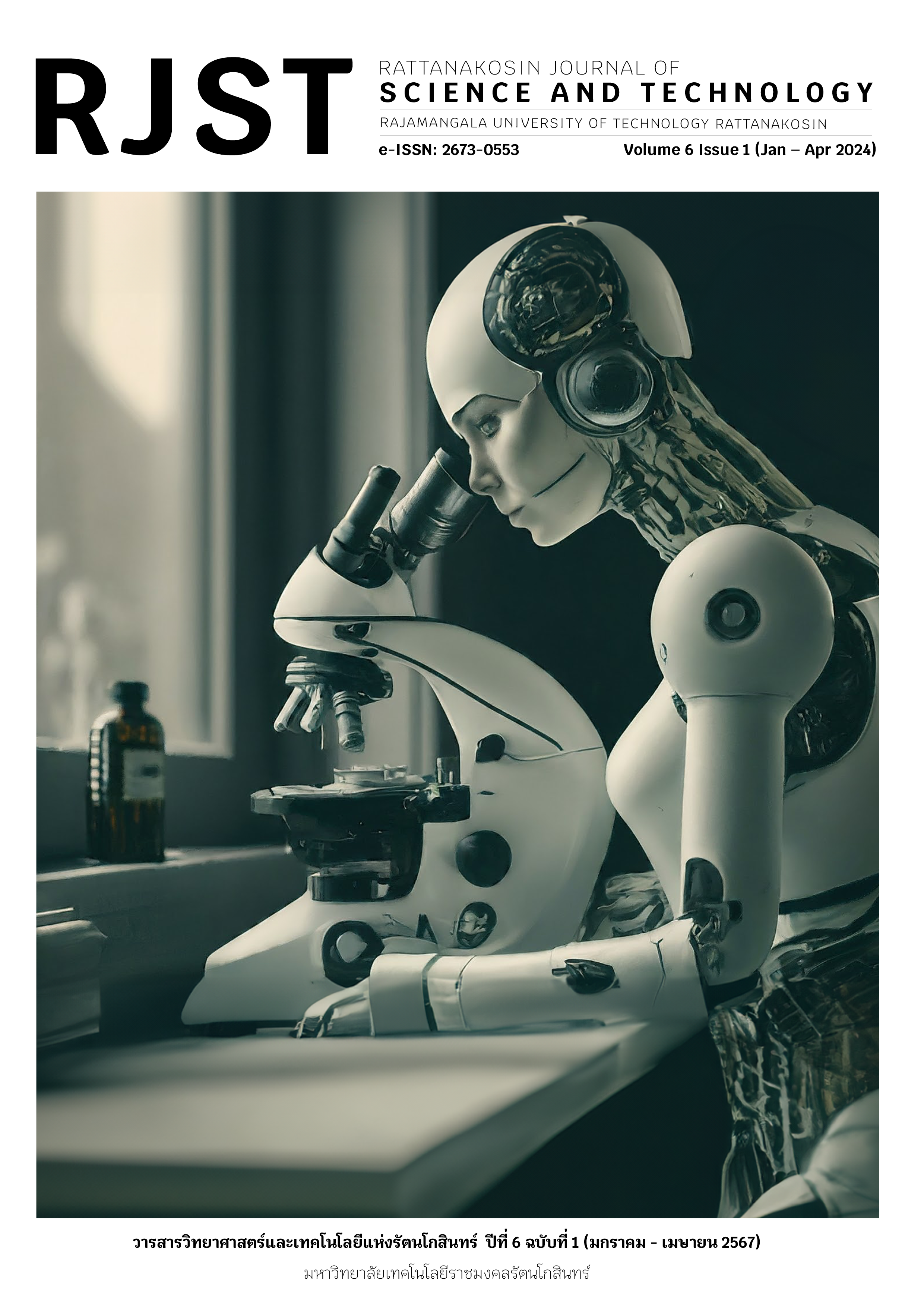An Experimental Study of Solar Chili Dryer with Volcanic Rock Thermal Storage
Main Article Content
Abstract
The aimed of this research to experimentally study of chili solar dryer efficiency with volcanic rock thermal storage. The first solar dryer was a solar dryer without volcanic rock thermal storage (SD1). The second solar dryer was a solar dryer with basalt rock thermal storage (SD2). The last solar dryer was a solar dryer with pumice rock thermal storage (SD3). The air flow rate was varied to 0.0142 m3/s 0.0208 m3/s and 0.0279 m3/s. The chili was dried to final moisture content of 13% (w.b.) from the initial moisture content was 75% (w.b.). The result from drying found that the solar dryer efficiency increased when the air flow rate was increased for all test set. The maximum solar dryer efficiency in this test when the air flow rate of 0.0279 m3/sec. The average efficiency of the solar dryer without volcanic rock thermal storage, the solar dryer with basalt rock thermal storage and the solar dryer with pumice rock thermal storage were 25.34%, 28.00% and 30.73%, respectively. The lowest drying time of solar dryer with pumice rock thermal storage was 23.20 hours and the highest efficiency was 30.73%
Article Details

This work is licensed under a Creative Commons Attribution-NonCommercial-NoDerivatives 4.0 International License.
The content within the published articles, including images and tables, is copyrighted by Rajamangala University of Technology Rattanakosin. Any use of the article's content, text, ideas, images, or tables for commercial purposes in various formats requires permission from the journal's editorial board.
Rajamangala University of Technology Rattanakosin permits the use and dissemination of article files under the condition that proper attribution to the journal is provided and the content is not used for commercial purposes.
The opinions and views expressed in the articles are solely those of the respective authors and are not associated with Rajamangala University of Technology Rattanakosin or other faculty members in the university. The authors bear full responsibility for the content of their articles, including any errors, and are responsible for the content and editorial review. The editorial board is not responsible for the content or views expressed in the articles.
References
เสริม จันทร์ฉาย. (2553). แผนที่ศักยภาพพลังงานแสงอาทิตย์จากข้อมูลดาวเทียมสำหรับประเทศไทย. กรมพัฒนาและส่งเสริมพลังงาน ร่วมกับภาควิชาฟิสิกส์ มหาวิทยาลัยศิลปากร.
สุห์ดี นิเซ็ง, ภาณุมาศ สุยบางดำ, กฤษณพงค์ สังขวาสี, สุพัตรา เพ็งเกลี้ยง. (2562). การศึกษาผลของขนาดช่องระบายความชื้นสำหรับการอบแห้งพริกด้วยเครื่องอบแห้งพลังงานผสมผสาน. วารสารวิจัยมหาวิทยาลัยเทคโนโลยีราชมงคลศรีวิชัย, ปีที่ 11 ฉบับที่ 1 มกราคม - เมษายน 2562 : pp 158-168.
สุรชัย ณรัฐ จันทร์ศรี. (2560). การศึกษาสมรรถนะเครื่องอบแห้งผลิตภัณฑ์ทางการเกษตรโดยใช้พลังงานแสงอาทิตย์ร่วมกับเชื้อเพลิงชีวมวล. วารสารวิศวกรรมศาสตร์ มหาวิทยาลัยศรีนครินทรวิโรฒ, ปีที่ 12 ฉบับที่ 1 มกราคม - มิถุนายน 2560 : pp 1-10.
ธีรพงศ์ บริรักษ์. (2562). การเพิ่มประสิทธิภาพเชิงความร้อนของตู้อบแห้งโดยการปรับมุมเอียงคล้อยตามแสงอาทิตย์. วารสารวิศวกรรมศาสตร์ มหาวิทยาลัยศรีนครินทรวิโรฒ, ปีที่ 14 ฉบับที่ 1 มกราคม - มิถุนายน 2562 : pp 23-32.
พงษ์สวัสดิ์ คชภูมิ. (2565). เครื่องอบแห้งพลังานแสงอาทิตย์ระบบไฮบริดแบบมีระบบแจ้งเตือน. วารสารวิชาการมหาวิทยาลัยอีสเทิร์นเอเชีย ฉบับวิทยาศาสตร์และเทคโนโลยี, ปีที่ 16 ฉบับที่ 1 มกราคม - เมษายน 2565 : pp 175-189.
ณัฏฐ์ธนัน กีรติญาดาธนภทัร, ประทีป ตุ้มทอง. (2559). การอบแห้งไข่น้ำด้วยเทคนิคฟลูอิไดซ์เบด. วารสารวิทยาศาสตร์ คชสาส์น, ปีที่ 38 ฉบับที่ 2 กรกฎาคม-ธันวาคม 2559 : pp 12-21.
สมชาติ โสภณรณฤทธิ์. (2540). การอบแห้งเมล็ดธัญพืช, พิมพ์ครั้งที่ 5, คณะพลังงานและวัสดุ, สถาบันเทคโนโลยี พระจอมเกล้าธนบุรี, 338 หน้า.
กรมทรัพยากรธรณี. (2545). รายละเอียดของหินไรโอไลต์, หินพัมมิช และหินบะซอลต์. [ออนไลน์]. ได้จาก: https://www.dmr.go.th/ รายละเอียดของหินไรโอไลต์-หินพัมมิช-และหินบะซอลต์/.
กิตติเทพ เพื่องขจร. (2550). การกักเก็บพลังงานแสงอาทิตย์ในรูปแบบความร้อนในหินถม. รายงานการวิจัย มหาวิทยาลัยเทคโนโลยีสุรนารี.
ยุธนา ศรีอุดม อนุรัตน์เทวตา สังคม สัพโส และ นิวัตน์ ประทุมไชย. (2564). การศึกษาเชิงทดสอบการใช้น้ำสำหรับระบายความร้อนออกจากแผงเซลล์แสงอาทิตย์. วารสารวิชาการและวิจัย มทร.พระนคร. 15 (2) กรกฎาคม - ธันวาคม 2564 : pp 1-13.
E. C. Okoraigwe, M. N. Eke and H. U. Ugwu. (2013). Design and evaluation of combined solar and biomass dryer for small and medium enterprises for developing countries. International journal of physical science, vol. 8 (25) 2013: pp. 1341-1349.
A. Zomirodian and M. Zamanian. (2012). Designing and evaluating an innovative solar air collector with transpired absorber and cover. ISRN renewable energy, Volume 2012: pp. 1-5.
A. A. Hassanain. (2009). Simple solar drying system for banana fruit. World journal of agricultural sciences, vol. 5 (4) 2009: pp. 446-455.


